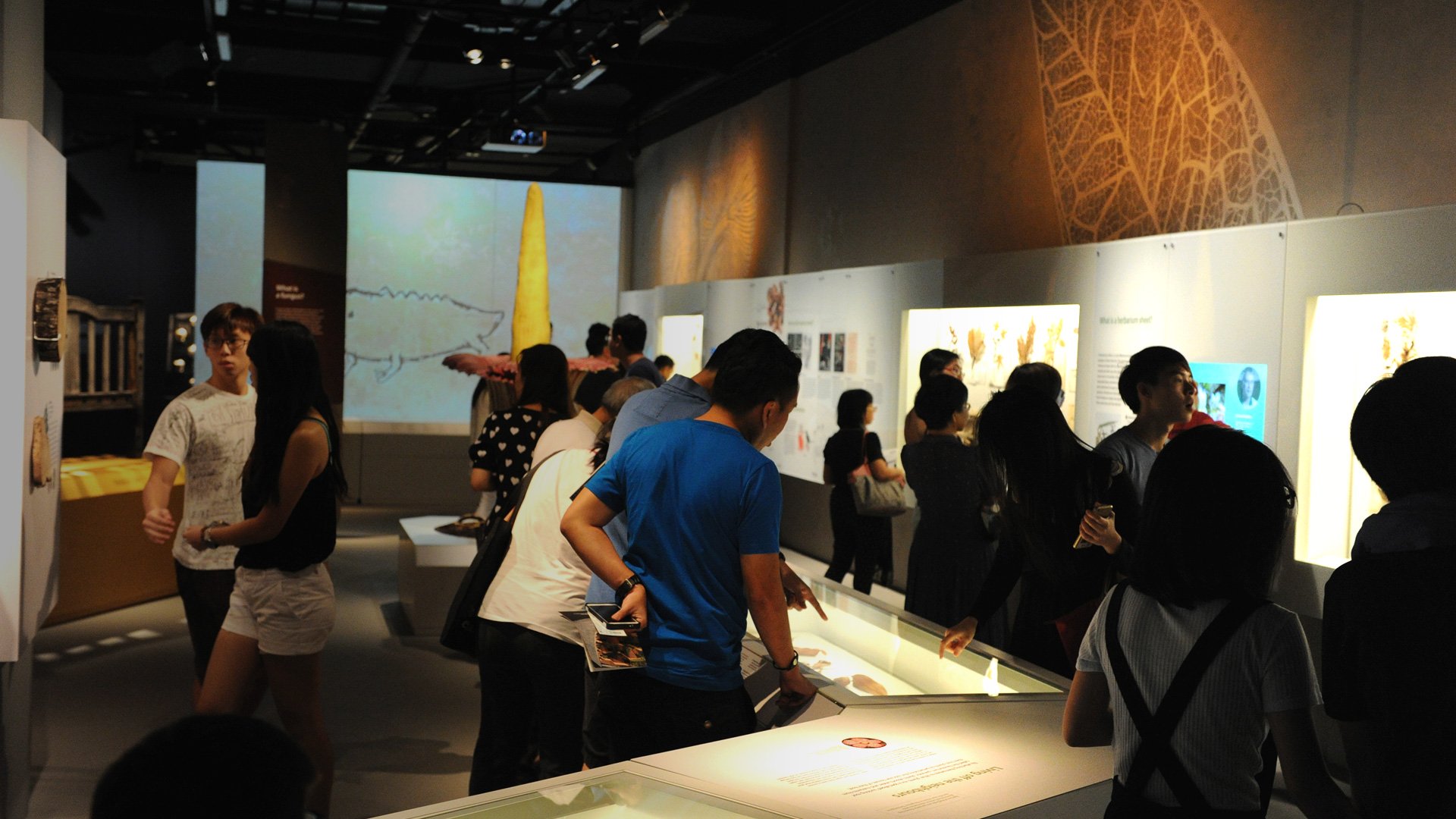Out of the Water
March 2017 – December 2017

The narratives of myths and legends of natural history are interpretive trails of human/nature interactions experienced by our ancestors. These were their attempts to rationalise and record nature’s mysteries so that they could share them with future generations.
At a time when our vulnerabilities where heightened by our lack of knowledge of natural phenomena, these stories developed a cloak of plausibility. The less we knew, the more mysterious and frightening they were. These are the beliefs which helped us shape the creation of mermaids, sea-dwelling monsters, and other magical animals.
Rich mythological views of animals have embodied and inspired cultures across Southeast Asia for millennia, many of which survive today. These ancient narratives are important – not only as a link to the past, but also how we have used myths to explain away our naivety. In order to understand the scientific basis for these stories, we must carefully dissect the myth like a consummate detective, and to scientifically study the reasonable, evidential aspects of texts and theories. The mysterious and illogical always excites. It is after all human nature, and the nature of science.
Culture and science are not in conflict.
Even if every mystery can be explained, demystified, or dismissed, myths will remain deeply embedded in human culture. It’s a necessary record of what we were like, and how we got to where we are today. As Shakespeare said, the past is prologue – only when we know what we are, where we came from, and how we got here, can we remain a sentient species. A people without a memory is like a man without a soul. We can only progress as a species by exploring and understanding our past.
Culture and science together – hand in hand.
“When you have eliminated the impossible, whatever remains, however improbable, must be the truth”
–Sir Arthur Conan Doyle
HIGHLIGHTS OF THE EXHIBITION
The exhibition explored and demystified some well-known folk tales of Singapore and the region.
SIRENS OF THE SEA
Sirens of the ancient Greek seas; rendering sailors shipwrecked, seduced across the waves by the unearthly calls of mysterious beauties. The misery of years at sea led sailors to believe visions of pale bodies cresting the shallows were those of beautiful sea-dwelling women – mermaids.
Today, these sirens are the namesake of the scientific order Sirenia, which contains four living species of herbivorous aquatic mammals: the dugong, and three species of manatees.
The Dugong, Dugong dugon (Müller, 1776), is distinguished from manatees in having a forked tail, instead of a paddle-shaped one. Unlike the manatees, dugongs are restricted to a marine environment owing to its dependence on seagrass thriving in shallow, tropical waters. Their distribution ranges from the coasts of northern Australia, through the Indo-west Pacific, and to the east African coast.
In Southeast Asia, storytelling evidence of human-dugong contact was found in the 3,000-year-old cave paintings of GuaTambun in Ipoh, Peninsular Malaysia. ‘Dugong’ (derived from the Malay word ‘duyung’) means ‘Lady of the Sea’.

Photo credit: Tan Heok Hui, 2017
Dugong skin♀
Dugong dugon (Müller, 1776)
Singapore, PulauTekong, 2006
Young dugongs tend to be pale cream in colour while older ones become brownish-grey. The colour of the skin and the shape of the upper body and flippers, combined with the refraction and distortion of the water, all contributed to the visage of humans floundering beneath the water. This resemblance prompted heroic sailors to plunge to their rescue.
ATTACK OF THE TODAK
The waters in the south of Singapore were said to have been plagued by fish with sword-like jaws. The havoc they wreaked transformed this trade route into a perilous journey; the fish would jump out of the water impaling fishermen and sailors.
The Sultan of Singapura ordered his soldiers to fight the fish, but the fish jumped up and stabbed them. Though only seven years old, Hang Nadim suggested using banana stems to barricade the shore. The fish leapt like darts into the stems and were stuck, enabling the remaining soldiers to kill them. The Sultan became jealous of the boy fearing he would take over the throne, and ordered his men to kill him. As they prepared to capture Hang Nadim, an old woman conjured a gush of red resembling blood that stained the hillside, which is today known as Bukit Merah (Redhill).

Photo credit: Tan Heok Hui, 2017
Hound Needlefish
Tylosurus crocodilus (Péron & Lesueur, 1821)
Singapore, St. John’s Island, 2013
There are several species known as ‘needlefish’, however, the Hound Needlefish is the largest needlefish in the region, measuring up to 1.5 metres. It is also the most probable species for the Bukit Merah legend. Needlefish are skittish dwellers near the surface of the water and tend to leap out when frightened. They have been known to injure and even kill people, but these are unintentional ‘attacks’ as they are merely seeking an escape.
HOOVES TO FINS
Legend has it that a mousedeer, Sang Kancil, loved to eat tropical fruits. One day whilst drinking at the river, a fruiting water apple or Jambu Air tree on the opposite bank caught his eye. Unable to swim over, he had to devise a plan.
Lurking in the nearby waters was the crocodile, Sang Buaya. Sang Kancil called out to him and explained that the Sultan had ordered a count of the crocodiles to invite them to a royal feast. Relishing this prospect, Sang Buaya and his friends happily obliged and lined up side by side across the river, thereby forming a bridge. Proud of his crafty lie, Sang Kancil hopped across the crocodiles, counting each one out loud. Upon reaching safety on the other side, he happily dashed away and helped himself to the juicy, fallen fruit.

Photo credit: Tan Heok Hui, 2017
Lesser Mouse-deer
Tragulus kanchil (Raffles, 1821)
Indonesia, Pulo Padang, 1906
Although a legend, Sang Kancil would have been a Lesser Mouse-deer; the smallest of all known hoofed mammals and the smaller of two species of mouse-deer found in the forests of Singapore. There have been no recorded observations of the Lesser Mouse-deer swimming, unlike the Greater Mouse-deer and its Sri Lankan and African relatives.

Photo credit: Tan Heok Hui, 2017
Ear bone of Sperm Whale♀
Physeter macrocephalus Linnaeus, 1758
Singapore, Jurong Island, July 2015
Scientists have established a close relationship between cetaceans and even-toed ungulate (or hoofed) mammals. An important piece of evidence was found in 2007 when a fossil of Indohyus, a mouse-deer-like mammal from the Eocene period (around 48 million years ago), was discovered. Notably, Indohyus had ear bones that share a similarity with cetaceans that is not present in other known mammals.
“NOT A MONSTER, JUST A WHALE”
In 1936, 42 miles south from Singapore, a 46-foot ‘sea monster’ with no feet but a large tail, was found on the shores of PulauSugi. On the then Dutch island, it was dismembered by the staff of the Raffles Museum. A flurry of media reports indicated fervent interest from national and international bodies, along with widespread public curiosity. It was described as having “elephant ears and 11-foot tusks”, its surface “greenish-black and smooth” and massive body tapering into a giant tail. Fishermen may have fled in fear, but scientists gravitated towards this creature dubbed, in Malay, ‘gajarlaut’ (sea elephant).
Upon closer scrutiny and a published statement by the then Director of Raffles Museum, F.N. Chasen, it was decided that it was “just a whale.” Identified as a Bryde’s Whale, Balaenoptera edeni Anderson, 1878, the fantasy was shattered. It was no monster.

Photo credit: Tan Heok Hui, 2017
Baleen plate
Balaenoptera sp.
Donated specimen, 2015
The distinguishing feature of the cetacean suborder Mysticeti is the baleen plate made of keratin, a type of protein. Over 100 plates can be found lining the upper jaws of baleen whales such as the Bryde’s Whale, allowing them to filter feed on krill, copepods and other crustaceans during skim feeding at the ocean surface, or feeding at the bottom of the ocean.

Photo credit: Tan Heok Hui, 2017
Antarctic Krill
Euphausia superba Dana, 1850
Australian Antarctic Territory, Shackleton Ice Shelf, 2010
Living within densities in the tens of thousands, krill (closely related to shrimps and prawns) is one of the main source of sustenance for baleen whales. The biomass of krill in the Antarctic ranges from 125 to 725 million tonnes; the largest shoals of krill are visible from space and can be tracked by satellite. [Specimens courtesy of Australian Museum]
MARINE POLLUTION
It is time to dispel the myth that the ocean is able to absorb all the impacts that humanity forces upon it. Increasingly, we can observe the biological, chemical and physical consequences of the stress we are placing on the ocean and its inhabitants. Toxic chemicals passively or actively leak (or are poured!) into the sea, accumulating in food webs and adversely affecting top predators. Ships traversing the world’s oceans carry ballast waters inevitably filled with foreign organisms that would be discharged into new ecosystems with sometimes terrible consequences. The ocean has long been our dumping ground for all manner of non-biodegradable waste – discarded nets that kill indiscriminately, plastic straws lodged in turtles’ nostrils, plastic bags in whales’ guts, microplastics etc. When will start behaving as responsible citizens of planet Earth and reverse the ocean’s declining health?

Photo credit: Tan Heok Hui, 2017
Anchor Tuskfish
Choerodon anchorago (Bloch, 1791)

Photo credit: Tan Heok Hui, 2017
Red Egg Crab
Atergatis integerrimus (Lamarck, 1818)

GALLERY IMPRESSION: Out of the Water, 2017
TO WHALES, ALIVE
Photographs by Tony Wu
Winner of the 52nd (2016) and 46th (2010) Wildlife Photographer of the Year award (Underwater category) organised by the Natural History Museum in London, Tony Wu is a photo-naturalist and a full-time marine photographer. Discover more of Tony’s work here http://tonywublog.com/

BOOK LAUNCH OF ‘A WHALE OUT OF WATER’
The Salvage of Singapore’s Sperm Whale
Available from Kinokuniya and the Museum Shop
https://singapore.kinokuniya.com/products/9789811100055

Photo credit: Fatin Iesa, 2017

Photo credit: Fatin Iesa, 2017
FEATURED TALKS
Details on our past talks can be found at https://lkcnhm.nus.edu.sg/workshops/scientific-talks/
Giant Squid by Dr Kubodera 12 March 2017
Sperm Whales by @tonywu98 24 February 2017



